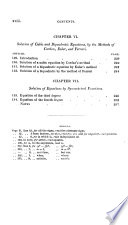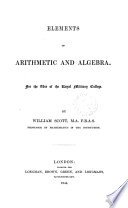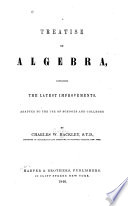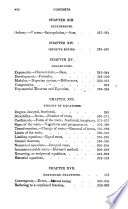 | John Radford Young - Algebra - 1832 - 408 pages
...equation of an odd degree has at least one real root of a contrary sign to that of the last term ; and every equation of an even degree, whose last term is negative, has at least two real roots with contrary signs. To determine the number of impossible roots in any equation is a problem of great... | |
 | John Radford Young - 1835 - 302 pages
...equation of an odd degree has at least one real root of a contrary sign to that of the last terra; and every equation of an even degree, whose last term is negative, has at least two real roots with contrary signs. NOTE. It must not be concealed from the student that our supposition of a + "J—/3... | |
 | John Radford Young - 1839 - 332 pages
...equation of an odd degree has at least one real root of a contrary sign to that of the last term ; and every equation of an even degree, whose last term is negative, has at least two real roots with contrary signs. SCHOLIUM. To determine the number of impossible roots in any equation is a problem... | |
 | William Scott - Algebra - 1844 - 568 pages
...transformed equation has one positive root ; therefore the proposed equation has one negative root. 263. Every equation of an even degree, whose last term is negative, has at least two real roots, the one positive and the other negative. For, making successively x=0 and x= + 7, two results of contrary... | |
 | Charles William Hackley - Algebra - 1846 - 542 pages
...but one, that root must necessarily have a contrary sign to that of the last term. Corollary 5. — Every equation of an even degree whose last term is...at least two real roots, and if there be but two, the one is positive, and the other negative. PROPOSITION IX. 249. The m roots of the equation X = 0,... | |
 | Charles William Hackley - Algebra - 1846 - 544 pages
...have a contrary sign to that of the last term. Corollary 5. — Every equation of an even degree whoso last term is negative has at least two real roots, and if there be but two, die one is positive, and the other negative. PROPOSITION IX. 249. The m roots of the equation X=0,... | |
 | Charles William Hackley - Algebra - 1846 - 542 pages
...but one, that root must necessarily have a contrary sign to that of the last term. Corollary 5. — Every equation of an even degree whose last term is negative has nt least two real roots, and if there be but two, the one is positive, and the other negative. PROPOSITION... | |
 | Stephen Chase - Algebra - 1849 - 348 pages
...the roots of an equation are imaginary, the last term must TOG positive (§ 21 6). Hence, Cor. in. Every equation of an even degree, whose last term is negative, has at least two real roots ; one positive, and the other negative (§§ 68. a ; 215. 2). 1. Given the roots, 5, 3+^/—4 3—... | |
 | Jeremiah Day - Algebra - 1854 - 428 pages
...positive. There must then be some positive number between 0 and p', which is a root of the equation. SSS. Every equation of an even degree, whose last term is negative, has at least two real roots, of different signs. For when zero is put for the unknown quantity x in the first member of the equation,... | |
 | William Smyth - Algebra - 1855 - 370 pages
...them, at least, will be real. 2°. The product of every pair of imaginary roots being of the form, a2 + b, is positive ; hence the absolute term of an equation...at least, two real roots ; and if there be but two, one of these will be positive and the other negative. In forming the equations, the most convenient... | |
| |